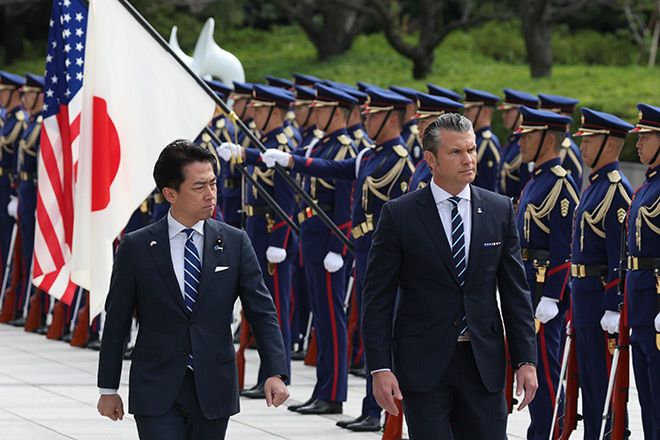Visiting U.S. Secretary of War Pete Hegseth pressed his Japanese counterpart on Oct. 29 in talks at the Defense Ministry in Tokyo to speedily increase the nation’s defense spending, as promised to the United States.
In the meeting, Defense Minister Shinjiro Koizumi conveyed Japan’s commitment to increase its defense budget and strengthen its defense capabilities based on the summit held the previous day between Prime Minister Sanae Takaichi and U.S. President Donald Trump.
At the joint news conference following the meeting, Hegseth welcomed Japan’s efforts to increase its defense budget and called for its “swift implementation.”
It was Koizumi’s first meeting with Hegseth since taking office the week before.
The meeting lasted about one hour.
Koizumi said he told Hegseth that Takaichi had announced a policy to achieve the current goal of raising defense spending to 2 percent of GDP by fiscal 2027 ahead of schedule within the current fiscal year.
He also outlined plans to accelerate the revision of three key national security documents, along with further increases in defense spending.
Koizumi called the Japan-U.S. alliance “the greatest alliance in the world,” and expressed Japan’s intention to fulfill its responsibilities for peace and stability in the Indo-Pacific region, which received strong support from Hegseth.
Meanwhile, Hegseth said at the news conference that he welcomed Takaichi’s commitment to increasing defense spending as part of strengthening the Japan-U.S. alliance.
Hegseth emphasized that he expects Japan’s defense budget increase to be implemented as quickly as possible.
When asked by reporters whether he had mentioned any numerical targets for Japan’s boost in defense spending, Hegseth stated that he had not made any demands of Japan, but emphasized that he had frankly conveyed the need for urgent, swift action and investment.
During the meeting, Koizumi and Hegseth also discussed the security situation in the Indo-Pacific region, with China’s increasing military activities in the East China Sea and South China Sea in mind.
Hegseth stated at the news conference that the Japan-U.S. alliance is essential to deterring China’s coercive actions and maintaining national security, and that efforts to strengthen the alliance would continue.
Koizumi said, “China is rapidly increasing its military power without sufficient transparency. We intend to respond calmly and resolutely to military developments around our country.”
Koizumi and Hegseth also agreed to strengthen coordination between the command and control systems of the Self-Defense Forces and U.S. Forces Japan, expand the presence of Japan and the United States in the southwestern islands, and enhance practical joint training.
Regarding cooperation on defense equipment, they confirmed plans to jointly produce the air-to-air missile AMRAAM (advanced medium-range air-to-air missile), as well as to further promote joint maintenance of U.S. military ships and aircraft.
During the summit between the nations’ leaders on Oct. 28, Takaichi conveyed Japan’s determination to independently pursue increased defense spending to Trump.
Trump praised Japan for significantly strengthening its military capabilities and expressed gratitude for Japan’s procurement of U.S.-made defense equipment such as fighter jets and missiles.
Hegseth’s praise for Japan’s military budget expansion aligns with Trump’s intentions.
During meetings in March and May between Hegseth and then-Defense Minister Gen Nakatani, the U.S. side reportedly did not mention specific numerical targets.
However, the U.S. side informally suggested raising the defense budget to 3.5 percent of GDP.
As a result, the planned July 1 “2+2” ministerial meeting between foreign and defense ministers in Washington was postponed.
In the meeting in Tokyo on Oct. 29, the Defense Ministry used the title “Secretary of War” for Hegseth for the first time, in accordance with the U.S. administration’s recent policy change, which renamed the Defense Department to the Department of War.
During the meeting, Koizumi presented Hegseth with a local specialty from his hometown of Yokosuka—an embroidered satin souvenir jacket known as “Sukajan.”
Hegseth was delighted and posted a photo on his X account after the meeting.
The gifted jacket was red, embroidered with hawks and roses, and included the name “Pete.”
Koizumi also prepared a matching blue one for himself and wore it together with Hegseth for a commemorative photo.
Additionally, Koizumi gifted a bronze statue of Oda Nobunaga, a 16th-century warlord known as a reformer, along with pancake mix for Hegseth, who is known for serving pancakes to his family.
On the previous day, the two accompanied Takaichi and Trump aboard the nuclear-powered aircraft carrier George Washington, deployed at the U.S. Navy’s Yokosuka Naval Base in Kanagawa Prefecture.
Koizumi and Hegseth reportedly spent about two hours together on board, often conversing without an interpreter.
“Although it was their first meeting, over the course of two days, they stood shoulder to shoulder like the Japan-U.S. alliance and were able to build a relationship of trust, which is reassuring,” a Defense Ministry official said.


AloJapan.com